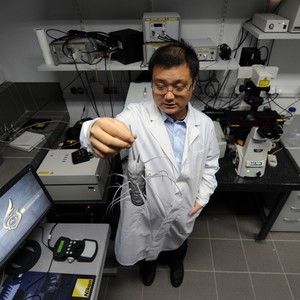A study conducted by a research team from the Institute of Physical Chemistry of the Polish Academy of Sciences(IPC PAS) in Warsaw, has changed the existing beliefs about the structure of polymers that forms bacterial cytoskeleton.
 The researchers from the Institute of Physical Chemistry of the Polish Academy of Sciences have shown that FtsZ polymers are even a dozen times as small as measured so far. The picture shows Dr. Sen Hou, the first author of the study.
The researchers from the Institute of Physical Chemistry of the Polish Academy of Sciences have shown that FtsZ polymers are even a dozen times as small as measured so far. The picture shows Dr. Sen Hou, the first author of the study.
Researchers have used an advanced measurement technique to describe the reasons for errors in the paste estimations. The team has shown that FtsZ polymers, which are the components of the bacterial cytoskeletons, are too short than it is believed until now, stated Dr. Sen Hou of IPC PAS.
The cytoskeleton is a 3-D network made of protein fibres. Tubular structures are one of the vital components of the cytoplasmic skeleton and in eukaryotic cells they are made of tubulin, a type of protein, and polymer fibres. The findings of the 1990s revealed that the cytoplasmic skeleton also exists in bacteria, which includes tubulin and FtsZ protein.
The IPC PAS team has conducted study on the length of polymers that is created by FtsZ proteins in Caulobactercrescentus bacteria. The team used the dynamic light scattering (DLS) method, also referred as photon correlation spectroscopy for the study. The technique enables the scientists to measure molecular sizes of less than one micrometer and to investigate processes in the duration ranging from microseconds to minutes.
The measurements have revealed that FtsZ protein’s typical fibre is very short and it includes just 9-18 monomers. The fibre’s total length is 100 nm, which is dozens of times shorter than the assumption made so far using measurements obtained with transmission electron microscopy (TEM).The study result better fits to the current understanding of chemical environment inside the cell. The research work on the structure of polymers in FtsZ protein secured financial support from the European Union and the Human Frontier Science Program Organization.
Source: http://ichf.edu.pl/